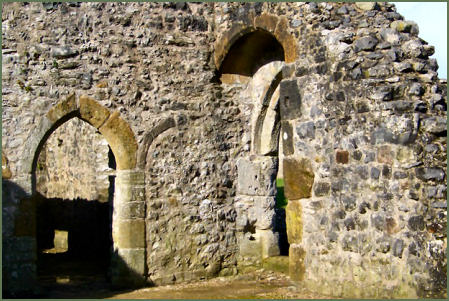Warton
OS Grid ref:- SD500726
 The village of Warton lies in northern Lancashire, close to the boundary with the neighbouring county of Cumbria.
The village of Warton lies in northern Lancashire, close to the boundary with the neighbouring county of Cumbria.
The village's name is believed to have derived from the Anglo-Saxon 'weard tun' meaning the watch out settlement.
Warton has connections with George Washington, the first President of the United States, it being the birthplace of the medieval ancestors of the president. His ancestor Lawrence Washington arrived in Warton in about 1300, Lawrence's great-grandson, Robert is said to have help build the clock tower of St Oswald's Church at Warton.
 The Washington family coat of arms, three mullets and two bars, is displayed in the church and the stars and stripes are flown on the village church flag pole every fourth of July. The flag was donated to the village after US soldiers visited during World War II and having returned to the United Staes informed their state senator about the birthplace of the Washington family. The flag was one which had flown above the Capitol Building in Washington DC.
The Washington family coat of arms, three mullets and two bars, is displayed in the church and the stars and stripes are flown on the village church flag pole every fourth of July. The flag was donated to the village after US soldiers visited during World War II and having returned to the United Staes informed their state senator about the birthplace of the Washington family. The flag was one which had flown above the Capitol Building in Washington DC.
A church existed at Warton well before the Norman Conquest of 1066. The oldest part of the present church of St. Oswald's (pictured right) is the south wall which dates to the fourteenth century, there were additions in successive centuries. A sedilla in the southeast chapel is thought to date from the late thirteenth or early fourteenth century. The lead lined font bears the date 1661. Incorporated into the nineteenth century pews are coats of arms, one of these being of the Washington family which is dated 1614. .
The ruined rectory (pictured above left) dates back to around 1267, the gables survive almost their original height (around 30 feet). Now in the care of English Heritage, it is a rare survival of a large fourteenth century stone house with great hall and chambers. The building served as a residence and courthouse for the wealthy and powerful rectors of Warton.
In the early thirteenth century the village became an important staging post on the route north to Carlisle, Northumbria and Scotland and was granted a charter for a Wednesday market during the reign of King John. Medieval “burgage” plots, long narrow strips of land for houses and their gardens, may still be seen between Main Street and Back Lane and there is a cluster of seventeenth century cottages near the Old School House, opposite the Church.
Warton Crag above the village consists of a mixture of limestone grassland with scrub and woodland. The site is nationally important for butterflies and moths. Peregrine Falcons regularly nest in the Main Quarry.
Nearby Places of Interest
Warton Crag -rising to 163 metres (535 feet) the crag is the highest point in the Arnside and Silverdale Area of Outstanding Natural Beauty (AONB).
Lancaster Castle founded in the tenth century
Leighton Hall - the lived-in house of the famous furniture making Gillow dynasty
Ashton Memorial in Williamson Park, Lancaster was commissioned by James Williamson, Baron Ashton as a tribute to his second wife, Jenny and was built between 1907 and 1909.
Butterfly House, Lancaster
